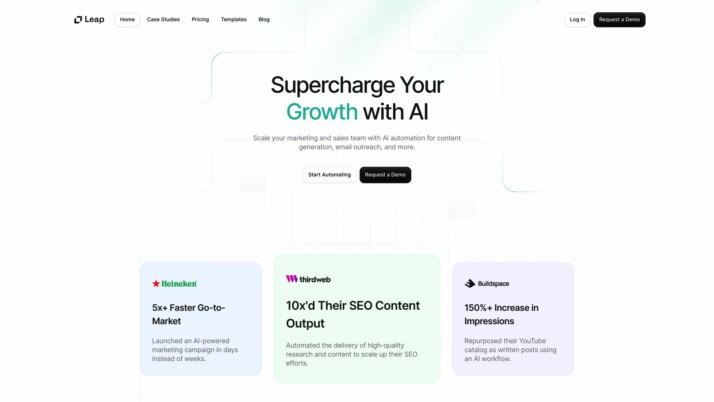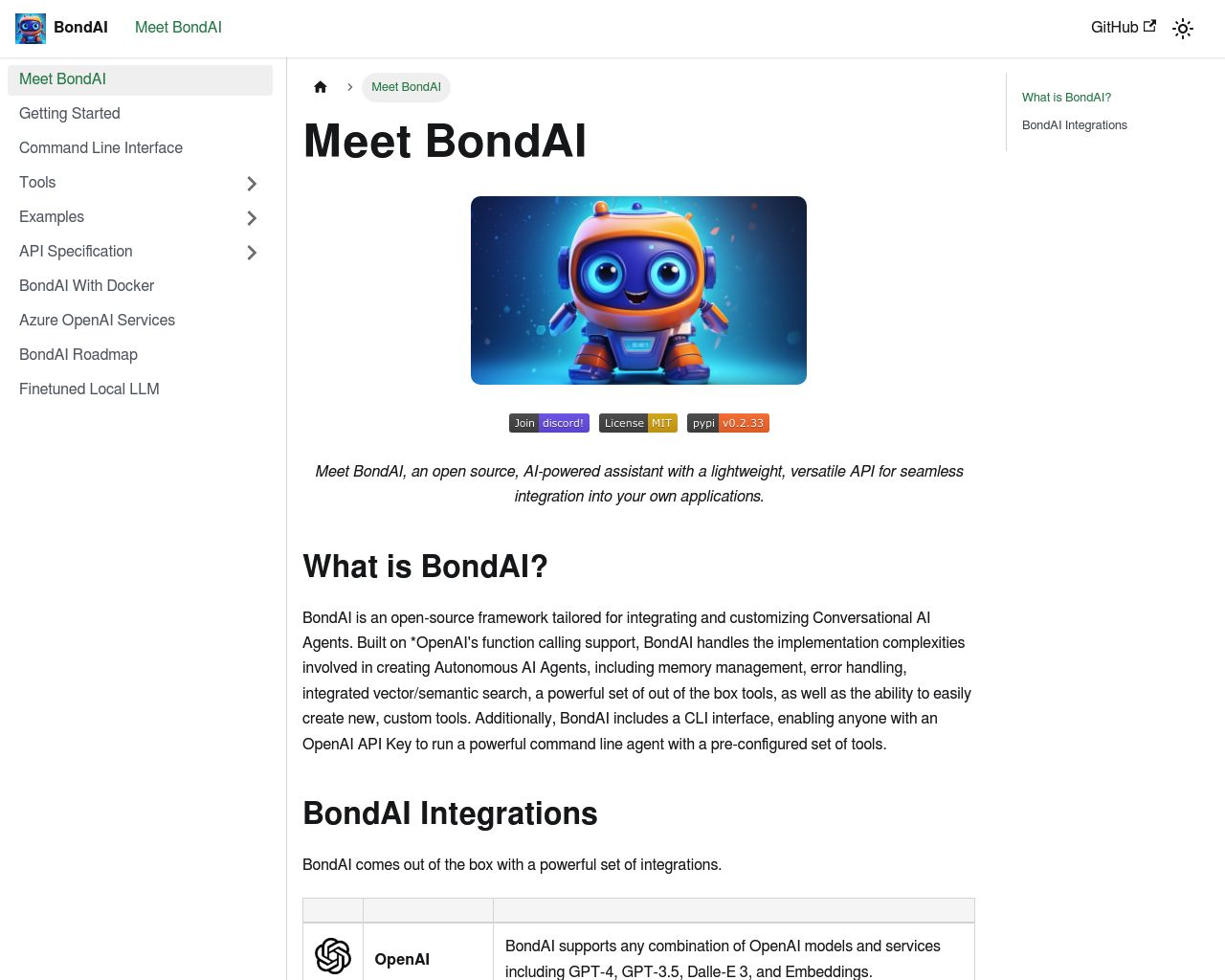Leap AI vs. BondAI: Comparing AI Agent Platforms
AI agent development platforms are revolutionizing how businesses and developers harness artificial intelligence. This comparison explores Leap AI vs. BondAI, and SmythOS, three distinct solutions in the AI agent landscape. Leap AI offers a user-friendly, no-code approach for quick AI workflow creation. BondAI provides an open-source framework for developers seeking granular control over AI agents. SmythOS emerges as a comprehensive platform, combining ease of use with advanced features like autonomous agents and debug mode. This review examines each platform’s strengths, limitations, and ideal use cases, helping readers choose the best tool for their AI development needs.
Leap AI Overview
Leap AI empowers users to build sophisticated AI workflows without coding expertise. This platform combines a user-friendly interface with powerful AI capabilities, making it accessible to both technical and non-technical users.


At its core, Leap AI offers a no-code environment for creating AI-powered applications. Users can leverage drag-and-drop tools to design complex workflows, integrating various AI models like OpenAI’s GPT, Mistral 7b, and Stable Diffusion XL. This versatility allows for the development of diverse applications, from automated content generation to intelligent data analysis.
Leap AI empowers users to build sophisticated AI workflows without coding expertise. This platform combines a user-friendly interface with powerful AI capabilities…
Leap AI stands out with its comprehensive SDK support, offering RESTful API, TypeScript, and Python options for seamless integration. The platform’s extensive template library accelerates development, providing ready-to-use solutions for common AI tasks such as blog post generation, music creation, and lead summarization. These features make Leap AI particularly valuable for businesses looking to rapidly prototype and deploy AI solutions.
The platform’s integration capabilities further enhance its utility. Leap AI connects effortlessly with popular tools like Slack, Hubspot, Zendesk, and Zapier, allowing users to incorporate AI functionalities into existing workflows. This interoperability positions Leap AI as a versatile solution for businesses seeking to enhance productivity across various departments.
While Leap AI offers impressive capabilities, it’s important to note potential limitations. The platform’s focus on no-code solutions may not fully satisfy advanced developers seeking granular control over AI models. Additionally, as with many AI platforms, users should be mindful of data privacy considerations when handling sensitive information through the system.
BondAI Overview
BondAI offers an open-source framework for developing AI Agent Systems. This platform simplifies the complexities of creating autonomous AI agents, addressing key challenges in memory management, context handling, and error resolution.


BondAI supports advanced AI architectures like ReAct Agents and ConversationalAgents, enabling both individual interactions and multi-agent systems. These capabilities allow for collaborative problem-solving among multiple agents, surpassing single-agent model limitations.
BondAI supports advanced AI architectures… enabling both individual interactions and multi-agent systems. These capabilities allow for collaborative problem-solving among multiple agents, surpassing single-agent model limitations.
The framework integrates seamlessly with popular services including OpenAI models, Microsoft Azure, Google Search, and LangChain. This extensive integration empowers users to create versatile applications across research, trading, home automation, and customer support domains.
BondAI’s robust memory management system, inspired by the MemGPT paper, employs a tiered approach for handling complex contexts and conversations. The system’s core, conversation, and archival memory structure enhances information retrieval and problem-solving capabilities.
Users can access BondAI through a Command Line Interface, Docker containers, or direct integration into codebases. This flexibility allows for quick starts with pre-configured tools or custom agent development. However, BondAI lacks some features like hosted agents and autonomous operations, which may limit its applicability in certain scenarios.
Feature Comparison
Leap AI and BondAI offer distinct approaches to AI agent development, each with its own strengths and limitations. Leap AI provides a user-friendly platform with drag-and-drop tools and pre-built templates, catering to users with limited coding experience. Its extensive integration capabilities with popular tools like Slack and Hubspot make it attractive for businesses seeking to enhance existing workflows. However, Leap AI lacks some advanced features such as autonomous agents and debug mode.
BondAI, as an open-source framework, offers more flexibility for developers who want granular control over their AI agents. It supports advanced AI architectures like ReAct Agents and ConversationalAgents, enabling sophisticated multi-agent systems. BondAI’s robust memory management system, inspired by the MemGPT paper, provides a significant advantage in handling complex contexts and conversations. However, BondAI doesn’t offer hosted agents or a visual builder, which may limit its accessibility for non-technical users.
In contrast, SmythOS bridges these gaps by offering a comprehensive platform that combines user-friendly features with advanced capabilities. SmythOS provides hosted agents for both development and production environments, a visual builder, and supports autonomous agents. It also includes critical features like debug mode, explainability, and transparency, which are absent in both Leap AI and BondAI. SmythOS’s ability to deploy agents as APIs, webhooks, and scheduled tasks, coupled with its scalability and security features, positions it as a more versatile and enterprise-ready solution compared to Leap AI and BondAI.
Feature Comparison Table
| Leap AI | BondAI | SmythOS | |
|---|---|---|---|
| CORE FEATURES | |||
| Hosted Agents (Dev, Production) | ❌ | ✅ | ✅ |
| Visual Builder | ✅ | ❌ | ✅ |
| No-Code Options | ✅ | ❌ | ✅ |
| Autonomous Agents | ❌ | ✅ | ✅ |
| Explainability & Transparency | ❌ | ✅ | ✅ |
| Debug Tools | ❌ | ✅ | ✅ |
| Multi-Agent Collaboration | ❌ | ✅ | ✅ |
| Audit Logs for Analytics | ✅ | ❌ | ✅ |
| SECURITY | |||
| Constrained Alignment | ❌ | ❌ | ✅ |
| IP Control | ✅ | ❌ | ✅ |
| COMPONENTS | |||
| Data Lakes | ❌ | ❌ | ✅ |
| DEPLOYMENT OPTIONS (EMBODIMENTS) | |||
| Staging Domains | ✅ | ❌ | ✅ |
| Deploy as Scheduled Agent | ✅ | ❌ | ✅ |
| DATA LAKE SUPPORT | |||
| Hosted Vector Database | ❌ | ❌ | ✅ |
| Sitemap Crawler | ✅ | ❌ | ✅ |
| YouTube Transcript Crawler | ✅ | ❌ | ✅ |
Best Alternative to Leap AI and BondAI
SmythOS emerges as the superior alternative to Leap AI and BondAI, offering a comprehensive platform for AI agent development and deployment. We combine user-friendly features with advanced capabilities, making AI accessible to both technical and non-technical users. Our visual builder and drag-and-drop interface simplify the creation of complex AI workflows, eliminating the need for extensive coding knowledge.
Unlike Leap AI and BondAI, SmythOS provides hosted agents for both development and production environments, ensuring seamless scalability and deployment. Our platform supports autonomous agents, enabling them to operate independently and collaborate in multi-agent systems. This feature surpasses the capabilities of Leap AI, which lacks autonomous agent functionality.
SmythOS excels in transparency and debugging, offering robust tools for explainability and a dedicated debug mode. These critical features, absent in Leap AI, allow users to understand and refine their AI agents’ decision-making processes.
SmythOS excels in transparency and debugging, offering robust tools for explainability and a dedicated debug mode. These critical features, absent in Leap AI, allow users to understand and refine their AI agents’ decision-making processes. Our platform also provides extensive integration options, connecting with various APIs, AI models, and tools, rivaling and often surpassing the integration capabilities of both Leap AI and BondAI.
We prioritize security and scalability, offering features like constrained alignment, data encryption, and IP control. These enterprise-grade security measures, combined with our flexible deployment options as APIs, webhooks, and scheduled tasks, position SmythOS as a more versatile and reliable solution for businesses of all sizes. Whether you’re a developer seeking granular control or a business user looking for no-code solutions, SmythOS delivers the tools and capabilities to bring your AI projects to life with unparalleled ease and efficiency.
Conclusion
Leap AI and BondAI offer distinct approaches to AI development, each with unique strengths. Leap AI provides a user-friendly platform with drag-and-drop tools and pre-built templates, ideal for businesses seeking to enhance existing workflows without extensive coding. BondAI, as an open-source framework, offers more flexibility for developers who want granular control over their AI agents, supporting advanced architectures and robust memory management.
However, SmythOS emerges as the superior solution, bridging the gaps between ease of use and advanced capabilities. We offer hosted agents for both development and production, a visual builder, and support for autonomous agents — features lacking in both Leap AI and BondAI. Our platform includes critical components like debug mode, explainability, and transparency, ensuring a more comprehensive and reliable AI development experience.
SmythOS’s ability to deploy agents as APIs, webhooks, and scheduled tasks, coupled with our scalability and security features, positions us as a more versatile and enterprise-ready solution. We provide the tools necessary for businesses to harness the full potential of AI, from simple automation to complex, multi-agent systems.
To experience the power and flexibility of SmythOS firsthand, we invite you to create a free SmythOS account today. Start building AI agents without any time limit or cost, and discover how our platform can revolutionize your approach to AI development and deployment. With SmythOS, you’re not just adopting a tool — you’re embracing the future of AI-driven innovation.
Last updated:
Disclaimer: The information presented in this article is for general informational purposes only and is provided as is. While we strive to keep the content up-to-date and accurate, we make no representations or warranties of any kind, express or implied, about the completeness, accuracy, reliability, suitability, or availability of the information contained in this article.
Any reliance you place on such information is strictly at your own risk. We reserve the right to make additions, deletions, or modifications to the contents of this article at any time without prior notice.
In no event will we be liable for any loss or damage including without limitation, indirect or consequential loss or damage, or any loss or damage whatsoever arising from loss of data, profits, or any other loss not specified herein arising out of, or in connection with, the use of this article.
Despite our best efforts, this article may contain oversights, errors, or omissions. If you notice any inaccuracies or have concerns about the content, please report them through our content feedback form. Your input helps us maintain the quality and reliability of our information.
